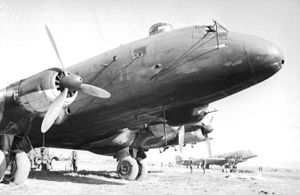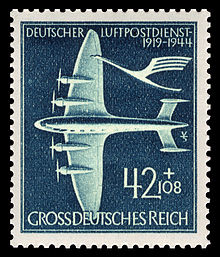Junkers Ju 90
| Junkers Ju 90 | |
|---|---|
 Two Ju 90s on an Italian airfield, March 1943 |
|
| Type: | Airliner , transport aircraft |
| Design country: | |
| Manufacturer: | |
| First flight: |
August 28, 1937 |
| Commissioning: |
1939 |
| Production time: |
1937-1939 |
| Number of pieces: |
18th |
The Junkers Ju 90 was a four-engine aircraft produced by the German manufacturer Junkers Flugzeug- und Motorenwerke in Dessau . The model was built from 1937 to 1939 and is also called Der Großes Dessauer after the Junkers-Werke headquarters .
development
The Ju 90 was an airliner that was developed from the Ju 89 bomber . In addition, the Ju 90 received a widened fuselage to accommodate 40 passengers and a modified engine system. Development began in January 1936, the first flight of the V1 took place on August 28, 1937. However, it was lost on February 7, 1938 during a test flight. The V2 flew on a trial basis in May and June 1938 in a 100-hour test at Deutsche Luft Hansa AG (DLH) . She crashed while starting in Gambia on a sales tour to South America on November 26, 1938, with the majority of the people on board perishing. Before the start of the war, DLH received the V3 and V4 as well as four aircraft from a total of ten aircraft series. Another four aircraft of this series were delivered to the DLH by May 1940. The remaining two aircraft had been ordered by South African Airways , but could no longer be delivered at the beginning of the war and were therefore taken over by the Air Force as transporters . The Ju 90 V5 and V6 received new wings and more powerful engines to address the shortcomings of the small-series Ju 90. The V5 was supposed to serve as a model aircraft for the DLH version (Ju 90 B), while the V6 was the transport version for the Air Force. The hull of the V6 was used to build the Ju 390 V1 in 1942 . Since the new wing did not prove itself, the following V7 and V8 received new outer wings and an extended fuselage. In particular, they differed from their predecessors in the use of the trapo flap, with which even large loads could be loaded through the fuselage floor. The following V9 and V10 were deleted, and the V11 continued as the new development Ju 290 V1 . This means that a total of 18 Ju 90s were built.
Lufthansa mission

At Lufthansa, the Ju 90 was one of the three most important aircraft in scheduled service in 1940 and 1941. In 1942 most of the aircraft had to be handed over to the Luftwaffe, which used them as transporters until the end of the war. The last Lufthansa aircraft was lost in an air raid on Stuttgart-Echterdingen on August 9, 1944. The Ju 90 flew a total of 3.8 million kilometers in scheduled traffic at DLH. Between April 15, 1940 and July 15, 1940, the DLH carried out the “Freight Special Service Vienna”. She flew tungsten ore and tin from Spain to the Reich on the route Vienna – Viterbo – Barcelona . After the armistice with France , the route could be run via Lyon until normal air traffic with Spain could be resumed on August 20, 1940. The worst accident of the DLH occurred with the Ju 90 D-AVMF, which crashed on November 8, 1940 near Brauna due to icing . 23 passengers and six crew members were killed.
Military operation
During operation weserübung , the occupation of Denmark and Norway, flew six Ju 90 in the 4./KGr. z. b. V. 105 as a transporter. Three Ju 90s with their Lufthansa crews were assigned to the Air Force in May 1941 and flew transports during the German support of the Iraqi uprising against the British occupying forces. Two aircraft were used as tow planes for the cargo glider Me 321 . In February 1942 all available Ju 90s were brought together in order to carry out supply flights in the northern section of the Eastern Front. a. for Demyansk to carry out. In November 1942 the Ju 90s were used for supply flights in the Mediterranean before they were relocated to the Eastern Front for Stalingrad supply in January 1943 . After that, the Ju 90s were used in the air transport squadron (LTS) 290 in the Mediterranean area. After the loss of North Africa, the squadron was relocated to Mühldorf am Inn in July 1943 . A short time later the name was changed to LTS 5, as there were no more Ju 290s. In the spring of 1944 the LTS 5 flew its missions during the evacuation of the Crimea . In September 1944 it was affiliated to TG 4 and helped to clear Greece in September and October 1944. The last aircraft were destroyed at the end of the war.
Attempts at air refueling
From 1943, a four-engine Junkers Ju 90 and later a six-engine Ju 390 fueled a twin-engine Focke-Wulf Fw 58 successfully in aerial refueling attempts in flight at the German Research Institute for Glider Flight (DFS) under the direction of Felix Kracht . However, due to a lack of fuel, one of the main problems faced by the German Air Force at the time, these attempts were stopped the following year.
Versions
- V1: W.-No. 4913, 4 × DB 600A (1050 PS)
- V2: mat. 4914, 4 × BMW 132 H / 1 (830 hp)
- V3: W.-Nr. 4915, 4 × BMW 132 H / 1
- V4: W.-Nr. 4916, 4 × BMW 132 H / 1, from late 1942 4 × Jumo 211 F (1200 hp)
- Small series: W.-Nr. 900001-010, 8 planes for the DLH with BMW 132 H / 1, 2 planes for SAA with Pratt & Whitney Twin Wasp SC-G (W.-No. 0002 and 0004, 1200 HP)
- V5: mat. 4917, 4 × BMW 132 M (970 PS), new wing
- V6: mat. 4918, 4 × BMW 139 (1500 PS), new wing, used in 1942 for conversion into Ju 390 V1
- V7: W.-Nr. 4919, 4 × BMW 801 A (1560 PS), modified wing, longer fuselage
- V8: mat. 4920, 4 × BMW 801, modified wing, longer fuselage
- V9 and V10: not built
- V11 and V13: became Ju 290
- V12: mat. 900001 in use for weapons testing at the Tarnewitz testing center
War propaganda
Incorrect information was often spread to confuse opponents. This also applied to the Ju 90 and Ju 290. It is therefore difficult for authors of specialist books to distinguish genuine from falsified statements and are therefore dependent on many, sometimes contradicting sources. Examples: The world altitude records allegedly achieved with the Ju 90 with payload were actually flown by the Ju 89 V2 in June 1938. The reference to the Ju 90 was only made for propaganda reasons . The only aircraft that was converted into another was the V6. The Ju 90 was not only developed after the Ju 89 was discontinued.
Technical specifications
| Parameter | Data |
|---|---|
| length | 26.45 m |
| span | 35.27 m |
| height | 7.05 m |
| Max. Takeoff mass | 22,980 kg |
| Top speed | 350 km / h |
| Cruising speed | 320 km / h |
| Service ceiling | 4900 m |
| Range | 1540 km |
| Engines | 9- four cylinder -Sternmotoren BMW 132H , each with 830 hp (610 kW) starting power |
See also
literature
- Wolfgang Wagner: Hugo Junkers aviation pioneer - his airplanes (= Die deutsche Luftfahrt. Vol. 24). Bernard & Graefe, Bonn 1996, ISBN 3-7637-6112-8
- Helmut Bukowski, Fritz Müller: Junkers Ju 90: a Dessau giant. Memories and reports from a Junkers aircraft inspector. Brandenburgisches Verlagshaus, Berlin 1995, ISBN 3-89488-083-X .
Web links
Individual evidence
- ↑ Performance statistics of Deutsche Lufthansa, Lufthansa archive, Cologne
- ^ Leo Niehorster : Scandinavian Campaign, German Airforce, Order of Battle X Air Corps April 9, 1940 , accessed on June 29, 2019.
- ^ Karl Kössler , Günther Ott: The great Dessauer. Aviatic, Oberhaching 1993, ISBN 978-3-925505-25-6


